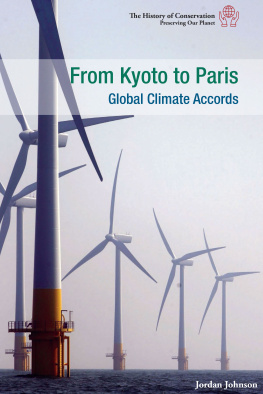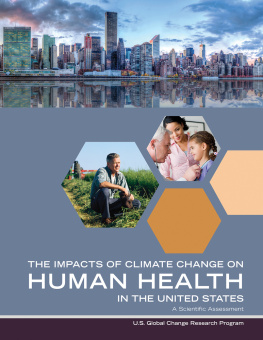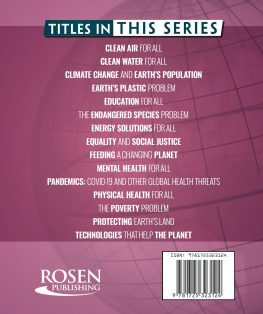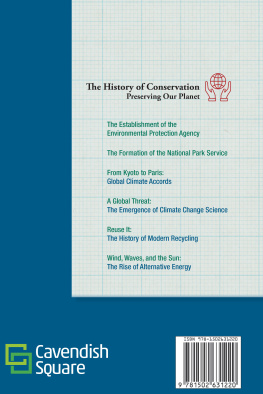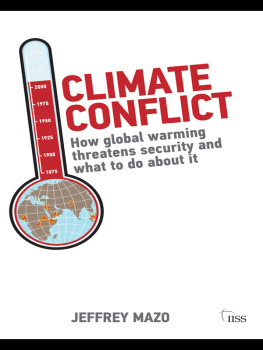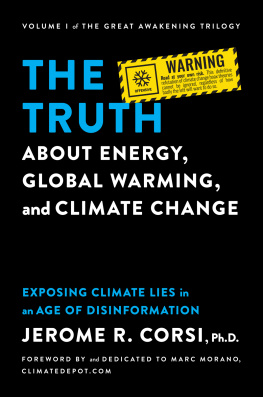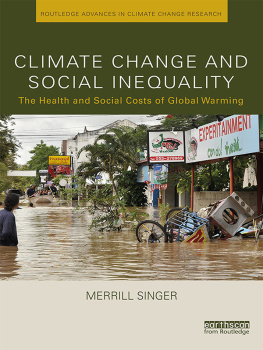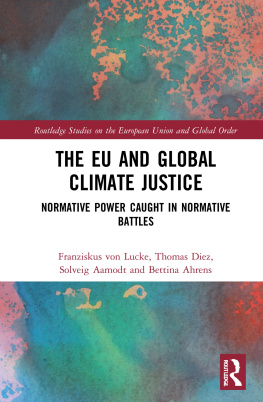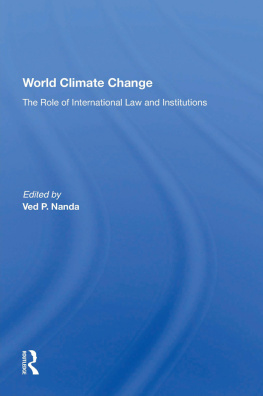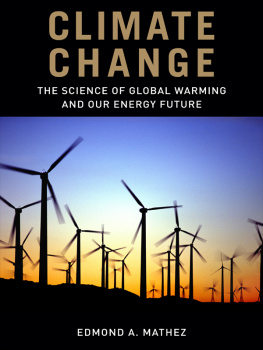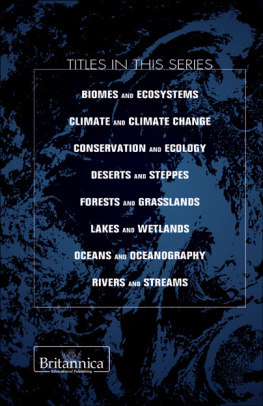- Chapter 1
The Road to Kyoto - Chapter 2
From Kyoto to Paris - Chapter 3
Beyond Kyoto and Paris - Chapter 4
Barriers to Cooperation - Chapter 5
The Legacy of International Environmental Protection
Published in 2018 by Cavendish Square Publishing, LLC
243 5th Avenue, Suite 136, New York, NY 10016
Copyright 2018 by Cavendish Square Publishing, LLC
First Edition
No part of this publication may be reproduced, stored in a retrieval system, or transmitted in any form or by any meanselectronic, mechanical, photocopying, recording, or otherwisewithout the prior permission of the copyright owner. Request for permission should be addressed to Permissions, Cavendish Square Publishing, 243 5th Avenue,
Suite 136, New York, NY 10016. Tel (877) 980-4450; fax (877) 980-4454.
Website: cavendishsq.com
This publication represents the opinions and views of the author based on his or her personal experience, knowledge, and research. The information in this book serves as a general guide only. The author and publisher have used their best efforts in preparing this book and disclaim liability rising directly or indirectly from the use and application of this book.
All websites were available and accurate when this book was sent to press.
Library of Congress Cataloging-in-Publication Data Names: Johnson, Jordan, author.
Title: From Kyoto to Paris: global climate accords / Jordan Johnson.
Description: New York : Cavendish Square Publishing, 2018. | Series: The history of conservation: preserving our planet | Includes glossary, bibliography, and index. | Audience: Grades 9-12. Identifiers: ISBN 9781502631244 (library bound) | ISBN 9781502631251 (ebook) Subjects: LCSH: Climatic changes--Juvenile literature. | Climate change mitigation--Juvenile literature. | Global warming--Juvenile literature.
Classification: LCC QC903.15 J64 2018 | DDC 577.22--dc23
Editorial Director: David McNamara Editor: Kristen Susienka Copy Editor: Rebecca Rohan Associate Art Director: Amy Greenan Designer: Lindsey Auten Production Coordinator: Karol Szymczuk Photo Research: J8 Media
The photographs in this book are used by permission and through the courtesy of: Photos credits: Cover Matt Cardy/Getty Images; p. 4 NASA; p. 7 Fredex8/iStock; p. 10 TDKvisuals/Shutterstock.com; p. 12 Hulton Archive/Archive Photos/Getty Images; p. 19 L. Prang & Co./Library of Congress; p. 20 Designua/Shutterstock.com; p. 23 Everett Historical/Shutterstock. com; p. 28 The Asahi Shimbun/Getty Images; p. 32 Christian Mueller/Shutterstock.com; p. 34 Arnaud Bouissou/COP21/ Anadolu Agency/Getty Images; p. 37 EuropaNewswire/Gado/Archive Photos/Getty Images; p. 41 United Archives GmbH/ Alamy Stock Photos; p. 47 Jasper Juinen/Bloomberg/Getty Images; p. 52 Angela Rohde/Shutterstock.com; p. 57 Pix One/ Shutterstock.com; p. 60 Praethip Docekalova/Shutterstock.com; p. 62 ZUMA Press Inc./Alamy Stock Photo; p. 67 Taina Sohlman/Shutterstock.com; p. 69 Mitch Johanson/Shutterstock.com; p. 70 Sasawat H/Shutterstock.com; p. 74 WIN-Initiative/ Getty Images; p. 78 J. Emilio Flores/Corbis Entertainment/Getty Images; p. 82 Fred Chartrand/The Canadian Press/AP Photo; p. 85 Win McNamee/Getty Images; p. 87 Chip Somodevilla/Getty Images; p. 90 Ron_Thomas/iStock; p. 94 Blend Images -KidStock/Brand X Pictures/Getty Images; p. 96 NASA/Wikimedia Commons/File:Earth Eastern Hemisphere.jpg/CC PD.
Printed in the United States of America
Opposite: This photo, called Earthrise, became one of the most iconic images of Earth.
O n December 24, 1968, a few photographs changed the world. Near the end of the space race, the astronauts aboard the Apollo 8 mission to the moon shared with people back on Earth a special broadcast of photographs of Earth and the surface of the moon. These were taken aboard the spacecraft, and a radio greeting from the astronauts could be heard by anyone listening in with a radio at home.
Earthrise and Its Impact
One of the most iconic photographs, Earthrise, captured the planet as a small and distant blue orb against a sea of the darkness of space. It publicly showed the world that there were no borders like those drawn on classroom maps. Earth was one entity. All earthlings had to share this space for the foreseeable future.
The experience of seeing all of Earth appearing so tiny and vulnerable deeply affected the astronauts. Astronaut Jim Lovell commented that the vast loneliness is awe-inspiring, and it makes you realize just what you have back there on Earth.
Not long after Earth got the chance to view its first selfportrait from nearly 240,000 miles (386,242 kilometers) away, perspectives on the planets health began to change. With the help of previous satellites launched during the United States rivalry with the Soviet Union in the field of space exploration, the increasing movement toward environmental care began to gain momentum. In a few short years, a massive movement devoted to protecting our lonely blue marble began to grow more rapidly. It was clear that if the image of Earthrise was to be honored, it would require international cooperation the likes of which had not been seen before. For a world overshadowed by the Cold War, this was no simple task.
In 1990, at the suggestion of scientist Carl Sagan, the Voyager 1 spacecraft took a picture of Earth from even farther away, showing it as a singular, pale blue dot from over 4 billion miles (6.4 billion km) away. The picture prompted Sagan to write in his book Pale Blue Dot. Look again at that dot. Thats here. Thats home. Thats us. On it everyone you love, everyone you know, everyone you ever heard of, every human being who ever was, lived out their lives ... on a mote of dust suspended in a sunbeam.
As Sagan and other scientists have recognized and eloquently stated in the past, Earth is the only home weve ever known. It is up to us to protect it. Over the past few decades, certain technologies have made humans more powerful and resilient than ever before. However, fuels and energies used to create these innovations are now causing a change in Earths climate. This change may pose the greatest risk to the human race. If human beings are to preserve the planet and themselves, they need to recognize that this world is all we have. This can and has prompted nations to cooperate and take action. For instance, some countries have banded together to limit the emissions of greenhouse gases and the rise in global temperature.
The symbol of three green arrows folding over and leading to each other is the icon for recycling.
A United Effort
In the 1990s and 2010s, two significant agreements were made regarding these issues. They were the Kyoto Protocol and the Paris Agreement. Both treaties sought to bring nations together to fight the global threat of climate change in various ways. They took a bit of convincing and faced many obstacles, but both enlisted powerful nations and ultimately spoke to individuals. The messages they presented were clear: without action on our part, the planet as we know it will face a difficult and irreversible road of danger.

